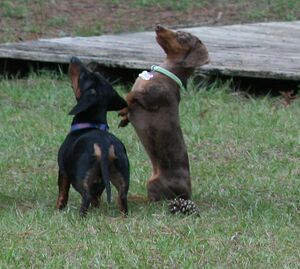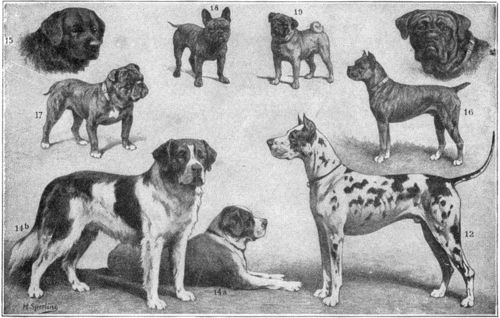Dog breed: Difference between revisions
imported>Aleksander Stos m (typo) |
imported>Aleksander Stos m (typo) |
||
| Line 25: | Line 25: | ||
<!--Can someone "caption" this photo? | <!--Can someone "caption" this photo? | ||
"The Basenji is a distinctive African dog breed"--> | "The Basenji is a distinctive African dog breed"--> | ||
Generally, before a type of dog is recognized as a breed, it must be shown that mating a pair of that type always produces dogs that have the same characteristics as the parents, usually both in appearance and in behavior. This is known as ''breeding true''. There are many issues concerning what is considered breeding true. For example, [[Flat-Coated Retriever]]s must always be black; however, yellow coats occur occasionally in some litters, due to [[recessive gene]]s. Kennel clubs do not recognize the yellow dogs as legitimate members of the breed; some breeders will kill the puppies rather than risk having the dog grow up, breed, and produce more of the undesired yellow color, perpetuating the | Generally, before a type of dog is recognized as a breed, it must be shown that mating a pair of that type always produces dogs that have the same characteristics as the parents, usually both in appearance and in behavior. This is known as ''breeding true''. There are many issues concerning what is considered breeding true. For example, [[Flat-Coated Retriever]]s must always be black; however, yellow coats occur occasionally in some litters, due to [[recessive gene]]s. Kennel clubs do not recognize the yellow dogs as legitimate members of the breed; some breeders will kill the puppies rather than risk having the dog grow up, breed, and produce more of the undesired yellow color, perpetuating the undesirable recessive gene; more often, today, such dogs are [[spaying and neutering|neutered]] and placed in homes as [[pet]]s. As another example, a breeding pair of [[Belgian Shepherd]]s of the [[Belgian Shepherd Dog (Groenendael)|Groenendael]] variety can produce puppies of the [[Belgian Shepherd Dog (Tervueren)|Tervueren]] (brown) variety; the [[American Kennel Club|AKC]] considers the varieties to be totally different breeds and, therefore, the brown puppies are invalid and undesirable dogs, whereas the [[CKC]] considers them simply to be different color varieties of the same breed. | ||
Of course, everything that distinguishes one breed of dog from another does so in the minds of ''humans'', not dogs. Each named breed of dog fits some human image of a particular variety of canine. Despite that, not all dog breeds were bred by people. Some came about because a group of domestic dogs were isolated from other dogs by geographic barriers, and over the generations produced [[progeny]] that were all, or mostly, of a recognizeable type. These breeds, called [[natural breed]]s, often originated in mountainous areas or islands. If they had qualities that people found attractive or useful, such distinctive dogs were further bred by fanciers using [[artificial selection]] - that is, puppies were born to females whose mates were chosen by the breeders, rather than left up to the dogs. An example of a dog breed that is the result of both natural selection in an isolated area and selective breeding by dog fanciers is the [[Newfoundland dog|Newfoundland]]. | Of course, everything that distinguishes one breed of dog from another does so in the minds of ''humans'', not dogs. Each named breed of dog fits some human image of a particular variety of canine. Despite that, not all dog breeds were bred by people. Some came about because a group of domestic dogs were isolated from other dogs by geographic barriers, and over the generations produced [[progeny]] that were all, or mostly, of a recognizeable type. These breeds, called [[natural breed]]s, often originated in mountainous areas or islands. If they had qualities that people found attractive or useful, such distinctive dogs were further bred by fanciers using [[artificial selection]] - that is, puppies were born to females whose mates were chosen by the breeders, rather than left up to the dogs. An example of a dog breed that is the result of both natural selection in an isolated area and selective breeding by dog fanciers is the [[Newfoundland dog|Newfoundland]]. | ||
Revision as of 12:14, 30 December 2007
A dog breed is a group of dogs that share a set of very similar features, including a characteristic appearance and behavior. The attributes that make a certain breed recognizeable as that breed are generally written into a formal "breed standard" by breed clubs, although some dog organizations do not use formal standards.
Some breeds have been defined primarily by their ability to do a job, like hunt, herd - or fight. Whether or not the animal is currently used in its traditional role, a good specimen of the breed retains the characteristics that enable it to carry out that original purpose.
Other breeds are more strictly defined by their appearance. Appearance includes a wide range of details such as the shape and proportions of the muzzle, the color of the coat, and the set of the tail. These details are called conformation points; they describe how well the animal conforms to the written breed standard.
No matter how much the appearance of an animal differs from one dog breed to the next, all dogs are the same species, Canis familiaris. That means that all fertile dogs are capable of mating with each other and producing puppies. If a breed "breeds true", then the progeny of two parents of a single breed will produce pups that share the breed characteristics.
History of dog breeds

It's easy to forget that until the industrial revolution brought us machines, animals were responsible for a great deal of labor. The routine place of a dog among people in past eras was as some kind of worker. Almost all of the known breeds from ancient times were specialized for some sort of job.
"The archeologic record suggests that the first domestic dogs are found in the Middle East approximately 14,000 years ago".[1]. There is every reason to believe that selective breeding for specific characteristics has occurred for thousands of years.
However long people have been breeding dogs, most of today's dog breeds have only been around for the last hundred years or so in their current forms. In the 1870s, kennel clubs were founded and kept records of breeds, setting breed standards and registering individual dogs. Those animals with credentials from the breed registries ("papers") are said to be "purebred". In show dogs, only individuals whose mother and father are both registered members of the breed are able to be registered, and considered purebred. This concept has caused controversy both because of the difficulty of regulation and because of the possible genetic consequences of a limited population (inbreeding). Recent work has been done to genetically classify the various breeds, with some surprising results regarding the estimated age and interrelations of the breeds.
Recognizing a new breed
One of the most contentious issues in dog breeding today is defining the point at which a distinct group of dogs becomes a breed. Traditionally, this has been easier with dogs bred to purpose; later, dogs were selected for appearance as well. As dog breeds have become more refined, the point at which a new variety becomes a breed can be difficult to decide. National kennel clubs often differ in their recognition of breeds and rare breeds might not be recognised outside their home countries. So a breed's status as being a "recognized" pure breed does not indicate how long it has been in existence as a distinct breed. Usually, only dogs recognized by a kennel club are eligible to compete in that specific club's conformation shows and dog sports, although many dog sports allow any healthy dog to compete regardless of the breed or registration.
Generally, before a type of dog is recognized as a breed, it must be shown that mating a pair of that type always produces dogs that have the same characteristics as the parents, usually both in appearance and in behavior. This is known as breeding true. There are many issues concerning what is considered breeding true. For example, Flat-Coated Retrievers must always be black; however, yellow coats occur occasionally in some litters, due to recessive genes. Kennel clubs do not recognize the yellow dogs as legitimate members of the breed; some breeders will kill the puppies rather than risk having the dog grow up, breed, and produce more of the undesired yellow color, perpetuating the undesirable recessive gene; more often, today, such dogs are neutered and placed in homes as pets. As another example, a breeding pair of Belgian Shepherds of the Groenendael variety can produce puppies of the Tervueren (brown) variety; the AKC considers the varieties to be totally different breeds and, therefore, the brown puppies are invalid and undesirable dogs, whereas the CKC considers them simply to be different color varieties of the same breed.
Of course, everything that distinguishes one breed of dog from another does so in the minds of humans, not dogs. Each named breed of dog fits some human image of a particular variety of canine. Despite that, not all dog breeds were bred by people. Some came about because a group of domestic dogs were isolated from other dogs by geographic barriers, and over the generations produced progeny that were all, or mostly, of a recognizeable type. These breeds, called natural breeds, often originated in mountainous areas or islands. If they had qualities that people found attractive or useful, such distinctive dogs were further bred by fanciers using artificial selection - that is, puppies were born to females whose mates were chosen by the breeders, rather than left up to the dogs. An example of a dog breed that is the result of both natural selection in an isolated area and selective breeding by dog fanciers is the Newfoundland.
- See selective breeding for a detailed discussion on the process of developing, and defining animal breeds, and registry (animal) for a discussion of recording and maintaining breeds as well as "open" versus "closed" stud books, and some of the issues concerning purebreds. Refer to dog group for a review of how dog breeds are organized.
References
- ↑ Robert K. Wayne, Elaine A. Ostrander: Origin, genetic diversity, and genome structure of the domestic dog BioEssays Volume 21, Issue 3, Date: March 1999, Pages: 247-257
Further reading
- D. Caroline Coile Ph.D. : Encyclopedia of Dog Breeds . Second Edition.2005

